#Shintoism
Explore tagged Tumblr posts
Text



Jujutsu Kaisen Phantom Parade.
#jujutsu kaisen#jjk#fushiguro megumi#yuji itadori#gojo satoru#nobara kugisaki#phantom parade#official art#shintoism
180 notes
·
View notes
Text
This Poster is so interesting

Okay, can we quickly talk about this poster? Because boy, this is interesting.
Maria's familiars are and always were inspired by Japanese/East Asian mythology. In the Games originally they were called Suzuku, Genbu, Byakko and Seiryu. We see Seiryu in the new trailer - I am assuming at least that the dragon we see is Seiryu.
But this here? This looks like a bear. I know, because I spent a good while obsessing over a certain bear. :P
No, but for real. This is very very interesting from the perspective of Japanese mythology. Because in the old Japanese mythology (aka pre-Heian) bears were thought to be manifestations of the gods. Something that still holds true for the Ainu mythology (as anyone who watched Golden Kamuy will have learned). But yes, originally the gods manifested as bears, with foxes as their messangers.
So, given that Maria's summons are all inspired by Japanese mythology, and I know that there are certain nerdy people in the crew, I am personally going to assume they are very much aware of this. Maria is summoning a god.
#castlevania#castlevania netflix#castlevania nocturne#maria renard#japanese mythology#shinto#shintoism#kami#kamuy#golden kamuy
189 notes
·
View notes
Text
Kannagi Nene Yashiro
I FORGOT I HAD TUMBLR SORRY YALL

Sketches <33




#foryou#tbhk#fyp#fypage#nene yashiro#fanart#tbhk yashiro#toilet bound hanako kun#yashiro nene#tbhk nene#shintoism#shinto#kannagi#jshk#jibaku shounen hanako kun
71 notes
·
View notes
Text
Oracles of the Three Shrines / Sanja Takusen (三社託宣)
This is one of my favourite teachings and piece of Shinto history. I've always really liked these, so I wanted to share with you all! It has a bit of a controversial history as you can read on the Kokugaukuin entry, but, it's important to note this - "However, even if assuming they were a forgery, the content of the oracles still had moral efficacy.
The oracles were thus not rejected as an effective means of cultivating the morals of the common people such as bringing about a sense of devotion for the kami, and won support from adherents of popular Shinto (tsūzoku shintō), teachers of practical ethics (sekimon shingaku) and persons connected with Buddhism espousing the unity of the three teachings, i.e. Shintō, Buddhism, and Confucianism.
A vast amount of handbooks, picture scrolls and prints were produced for the common people.
Moreover, pious associations (kō) offering dedicatory lanterns (tōrō) to the three shrines were formed in various places.
Faith in the sansha takusen deeply permeated the whole country and did not abate throughout the early modern period.."
(Additionally, many Sanja Takusen shrines for the three Kami-sama were enshrined and established together at particular Jinja, I remember in particular Kibitsu Jinja has a space for them!)
I adjusted the official English translation slighty (you can see the official one on Kokugakuin here) And, I've also included easy to read Japanese and explanation in Japanese as well - courtesy from this website page and the author
These teachings emphasize honesty, sincerity (spiritual 'cleanliness' / clarity), and mercy / compassion
----
Amaterasu Omikami-sama:
"If you plot and scheme to deceive people, you may fool them for a while, and even seem to have profited from doing so. But you will without fail be visited by divine retribution. To be deeply sincere and honest may have people shun you and speak ill of you, but in the end, such a person will receive the blessings of the sun and moon."
【天照皇大神宮】
ぼうけいはがんぜんのりじゅんたりといえども、かならずしんめいのばつにあたる。謀計は眼前の利潤たりと雖も、必ず神明の罰に当る。
訳:謀をめぐらして人を欺くことは、目前の利益になるかもしれないが、必ず神様の罰にあたるぞ。
しょうじきはいったんのえこにあらずといえども、ついにはにちげつのあわれみをこうむる。正直は一旦の依怙に非ずと雖も、終には日月の憐れみを蒙る。
訳:正しき直きこころはその場のたのみにならない場合もあるかもしれないが、最終的には神様の恵みをいただくぞ。
Hachiman Okami-sama:
"Follow sincerity without fail. Though one could attempt to eat a red-hot ball of iron, one must never eat food from a person with an insincere heart. Though one might sit above a blazing fire hot enough to melt copper, one must never go into the place of a person of an insincere mind. This is to keep a clear heart."
【八幡大菩薩】
てつがんをしょくすといえども、こころけがれたるひとのものをうけず。 鐵丸を食すと雖も、心汚れたる人の物を受けず。
訳:たとえ、食べ物がなく鉄の塊を食べたとしても、心汚れた人の食べ物は受けるなよ。
Kasuga Okami-sama:
【春日大明神】
"Even though you may see someone of a household who seems to have managed for long to avoid misfortune, the Kami will not enter into the household of a person with a perverse and cruel disposition. On the other hand, even though a man be in mourning for his father and mother*, if he is a man of compassion, the Kami will enter in his home. Compassion is all important."
せんにちのしめをひくといえども、じゃけんのいえにはいたらず。千日の注連(しめ)を曳くと雖も、邪見の家には到らず。
訳:たとえ、長い期間に亙って神聖な生活をしていて汚れていなく��も、邪な家には行ってはいけない。
じゅうふくしんこうたりといえども、じひのしつにおもむくべし。重服深厚たりと雖も、慈悲の室に赴くべし。
訳:たとえ、重い忌服であったとしても、死の穢れを厭うことなく、哀れみ慈しみ深い家には行かなければならない。
*[Traditionally, there is an idea someone in mourning would be considered to have kegare, negative energy, bad energy - and therefore the Kami-sama would avoid them and they should avoid the Kami-sama. But the teaching here says even though he is in mourning and may have kegare, his heart is pure and compassionate, so the Kami-sama will enter his home regardless]


#shinto#shintoism#sanja takusen#Amaterasu Omikami-sama#Amaterasu Omikami#Hachiman Okami#Hachiman Okami-sama#Kasuga Okami#Kasuga Okami-sama#Oracles of the Three Shrine
59 notes
·
View notes
Text
Happy pride to religious LGBTQ+ folks.
It never doesn’t hurt to see religious people, especially possibly from your own religion, hate you for just existing. Staying true to yourself and keeping your faith while doing so is something to have pride about🏳️🌈🏳️⚧️
Happy pride to all LGBTQ+ Muslims.
Happy pride to all LGBTQ+ Jews.
Happy pride to all LGBTQ+ Christians.
Happy pride to all LGBTQ+ Hindus.
Happy pride to all LGBTQ+ Buddhists.
Happy pride to all LGBTQ+ Sikhs.
Happy pride to all LGBTQ+ Shintoists.
Happy pride to all LGBTQ+ Taoists.
Happy pride to all LGBTQ+ Vodouists.
Happy pride to all LGBTQ+ Spiritualists.
Happy pride to all LGBTQ+ Shamanists.
Happy pride to all LGBTQ+ Confucians.
Happy pride to all LGBTQ+ Jains.
Happy pride to all LGBTQ+ Baháʼís.
Happy pride to all LGBTQ+ Zoroastrians.
Happy pride to all LGBTQ+ religious folks.
#mental health#positivity#self care#self help#recovery#happiness#pride#pride month#lgbtq#lgbt#christianity#islam#jewish#hinduism#buddhism#sikhism#shintoism#taoism#religion#lgbt positivity#body positivity#wlw positivity#positive reminders#body positive#pro recovery#autism#trans positivity#self love#self improvement#self care reminder
178 notes
·
View notes
Text

Miwa Komatsu — The Growth of the Lion Cub (acrylic, canvas, 2025)
48 notes
·
View notes
Text
Deities, Figures, And Spirits of Rebellion, Revolutions, and Resistance.

While Tensions are High and emotions flood the body and mind, I like to think back to time and how history has birthed incredible and magnificent people throughout its unforgiving march forwards. And I think of those figures and people or those gods and stories, and I remind myself of their presence and how they shook the time and the eras that they occupied. I’m in love with them. And I admire them. Whether they are trickster Spirits that stand against Authority and embrace strength against adversity or fighting against authority and resisting the status quo, I often admire and think of them. I think of them fondly and I nod to them through Space and Time, and by thinking of them, I carry them in my heart. And I am motivated by their Light and the Inspiration that they have brought across the ages. I know that they are *there*. Eons apart from me or in spaces and spirit that I cannot grasp anywhere but within my very spirit. They are there. And I am holding them in my spirit and heart and they are holding me. And I move with their spirit and their awareness. And I nod to them. And they, to me. I wanted to provide a large list of Figures, Saints, Gods or other individuals and Beings commonly venerated, worked with or worshiped as icons of resistance and overcoming trying times. History is steeped in trials and circumstances where the oppressed and hunted have overcome great adversity or stood against the tides that seek to bring harm unto them. Here, I will list figures that you can draw upon or look to in your hours of need. If you seek a Revolutionary, you may find one Here. (feel welcome to add some as this crosses your path!)
Some Saints:
St. Michael the Archangel – Known as the chief warrior angel, St. Michael is often invoked for protection and strength in battles and against evil.
St. Joan of Arc – The French saint who led her country in battles against English forces during the Hundred Years' War. She’s celebrated for her courage and conviction against overwhelming odds.
St. Jude Thaddeus – Known as the patron saint of lost causes, people turn to him in desperate situations for help in overcoming challenges that seem impossible.
St. Sebastian – Often depicted as a martyr who survived multiple executions, he became a symbol of strength, resilience, and steadfastness in the face of persecution.
St. George – Known for slaying a dragon, St. George is a symbol of overcoming evil and oppression. Often associated with courage in adversity.

Deities:
Sekhmet (Egyptian Mythology) – The lion-headed goddess of war and healing, Sekhmet is revered for her fierce power and for defending the oppressed.
Morrigan (Celtic Mythology) – The Celtic goddess of battle and sovereignty, Morrigan embodies both the power to protect and to incite change. She is often seen as a guardian of the land, appearing before battles to inspire or instill fear in the enemy.
Kali (Hinduism) – Goddess of destruction and rebirth, Kali represents the destruction of evil and is often invoked for overcoming difficult circumstances and for protection against oppressive forces.
Oya (Yoruba/Orisha Tradition) – Goddess of winds, storms, and transformation, Oya is a fierce warrior who stands up against oppression and is often turned to for protection and resilience. Ogun (Yoruba/Orisha Tradition) – The god of iron, war, and labor, Ogun is a force for justice and is often invoked in situations requiring resilience and the strength to overcome oppression. He’s seen as a revolutionary spirit for those seeking to break free from their constraints. Eshu (Yoruba/Orisha Tradition) – Known as the divine messenger and trickster, Eshu brings both disruption and opportunity. As a god of crossroads, he’s associated with challenging authority and initiating change, reminding followers that revolution often begins with unexpected choices. Yemaya (Yoruba/Orisha Tradition) – The mother of all life and goddess of the sea, Yemaya is often associated with resilience, protection, and the healing of generational trauma. As a nurturing and revolutionary spirit, she is frequently invoked for personal and collective strength. Queen Nanny of the Maroons (Jamaican Folklore) – A legendary figure and spirit in Afro-Caribbean culture, Queen Nanny was a leader of the Maroons who resisted British colonial forces. She’s honored as a warrior and symbol of independence and strength.
Huitzilopochtli (Aztec Mythology) – The god of war and the sun, Huitzilopochtli led the Aztecs through harsh conditions to establish their empire. He symbolizes endurance, perseverance, and overcoming obstacles.
Inanna/Ishtar (Mesopotamian Mythology) – Goddess of love, war, and justice, she descends into the underworld and returns, representing survival through dark times and resistance against forces of oppression.
Manjushri (मञ्जुश्री) (Buddhist Bodhisattva) - Manjushri is venerated across the Buddhist world as an embodiment of wisdom, with devotees seeking his guidance to develop the courage and insight necessary to face personal and societal challenges. Manjushri holds a flaming sword that symbolizes the cutting of ignorance and illusion, a powerful symbol of spiritual revolution and awakening. He represents the transformative power of wisdom and the courage to overcome ignorance, delusion, and societal conventions, which align with themes of inner revolution.
Susanoo (建速須佐之男命) (Japanese Shinto) – The god of storms and the sea, Susanoo is known for his rebellious nature against the heavenly order, and he’s often venerated for his unyielding spirit. He’s remembered for protecting people by slaying a great serpent, representing courage and the ability to challenge authority.
Amaterasu (天照大御神 / 天照大神) (Japanese Shinto) – Though primarily known as the goddess of the sun and order, Amaterasu withdrew from the world when her brother acted destructively, only returning when lured back by others. Her story reflects the themes of resilience and the power to restore light and hope.
Guan Yu (关羽) (Chinese) – A legendary general deified as a god of war and protection, Guan Yu is known for his loyalty, bravery, and sense of justice. He’s widely worshipped as a guardian figure who defends the oppressed and inspires people to uphold righteousness and loyalty.
Nezha (哪吒) (Chinese) – A child warrior deity known for his rebellious spirit, Nezha is celebrated for resisting oppression, particularly against tyrannical figures in the heavens. He represents youth, resilience, and defiance against unjust authority, often empowering those who feel marginalized or oppressed.
Xiwangmu (西王母) (Chinese) – Also known as the Queen Mother of the West, Xiwangmu is a powerful goddess associated with healing, protection, and transformation. While not a revolutionary in the typical sense, she embodies resilience, independence, and the power of women in a traditionally male-dominated pantheon.
Zhong Kui (钟馗) (Chinese) – Known as the demon slayer, Zhong Kui is a spirit of justice who fights against evil spirits and brings protection to those who feel haunted by oppression. He is venerated as a deity who can help people overcome fears and defeat obstacles that seem insurmountable.
The Eight Immortals (八仙) (Chinese) – A group of legendary Taoist figures, each with unique powers, who often challenged the social order. Figures like Lü Dongbin and Zhang Guolao used their abilities to help people and protect them from corrupt rulers and evil forces, embodying the spirit of defiance against oppressive systems.
Sun Wukong (孙悟空) (Chinese) - The central figure in the 16th century novel “Journey to the West (西游记) but also a figure in Mythology, Sun Wukong stands against authority and inspires both resistance and strength as well as dynamic growth.

Demons:
Lord Lucifer - The Adversary and Illuminator. Lucifer is a longstanding figure of bearing the light in the darkness and fighting against overwhelming oppression and control of powers that deem themselves tyrants. Lucifer fights and battles against forces that subjugate the oppressed.
Lord Asmodeus – Known in demonology as a figure representing strength, ambition, and power, Asmodeus is sometimes invoked for resilience, drive, and confidence to overcome personal and external challenges.
King Belial – Often associated with independence and personal power, Belial is sometimes venerated for helping people stand strong in their own beliefs and against unjust authorities.
Mother Lilith – A figure of independence and resistance, Lilith is revered in some traditions as a symbol of feminine power and autonomy, especially in standing against oppression and patriarchal structures.
Lord Buer – Demon of healing and knowledge, called upon for mental strength and overcoming illness or hardship through wisdom and resilience. Promotes mental health and healing as well as encourages growth through overcoming your mental blockages.
Lord Leviathan - The Lord of Shadow Working. Lord Leviathan helps you navigate the deep and dark waters of your mind where you may feel overwhelmed and drowning. Lord Leviathan can bring you clear waters and help support you when the tides feel like they may pull you down.

Secular Saints & Venerated Figures, Other Folkloric figures and Revolutionaries:
Harriet Tubman – Though not formally canonized, Harriet Tubman is often seen as a symbol of liberation and resilience, escaping slavery and leading others to freedom.
Malcolm X – An icon of strength, self-determination, and resistance, especially in the context of racial oppression. His life inspires resilience and the fight for justice.
Hypatia of Alexandria – Known for her wisdom and intellectual resilience, Hypatia became a symbol of strength and survival in a time when powerful figures often sought to silence knowledge.
Nelson Mandela – Revered globally for his resilience and role in overcoming apartheid, Mandela is a secular saint for many, representing strength and the spirit of resistance.
Frida Kahlo – Known for her resilience through physical and emotional pain, Kahlo’s life and work are often venerated as symbols of strength, personal power, and survival against all odds. Cuauhtémoc (Aztec/Mexica Tradition) – The last Aztec emperor who resisted the Spanish conquistadors. He is remembered as a hero who fought courageously to protect his people, embodying resilience and the spirit of resistance in Mexican culture.
Emiliano Zapata (Mexican Folk Hero) – Though not a deity, Zapata’s revolutionary spirit against oppressive forces has made him almost a legendary figure in Mexican folklore. He’s revered as a folk saint and a symbol of the fight for social justice and indigenous rights.
Hua Mulan (Chinese Folklore) – Celebrated for her bravery and willingness to challenge gender norms, Mulan fought in her father’s place in the army. Her story is a symbol of courage, resilience, and overcoming social constraints.
Kumari (Nepalese Tradition) – Known as the living goddess of Nepal, the Kumari is believed to embody divine power and protection for the people. She serves as a symbol of resilience and cultural endurance in the face of modernization and outside influence.
Zumbi dos Palmares (Afro-Brazilian Tradition) – A leader of a community of escaped slaves (Quilombo dos Palmares) in Brazil, Zumbi is honored as a hero and symbol of freedom, resistance, and African heritage in Brazil.
Yue Fei (岳飞) – A historical general from the Song Dynasty who became a symbol of loyalty, patriotism, and resistance against foreign invaders. Despite betrayal and wrongful execution, Yue Fei is venerated as a hero who embodies loyalty to one’s people and the fight against oppression.
Li Shimin (Emperor Taizong of Tang, 唐太宗 李世民) – Known for his role in overthrowing the corrupt Sui Dynasty, Li Shimin played a crucial role in establishing the Tang Dynasty. He is respected as a revolutionary leader who brought stability and cultural prosperity to China.
Chen Sheng and Wu Guang (陈胜, 吴广) – These two commoners led one of the first rebellions against the Qin Dynasty’s harsh rule, sparking what would eventually become a larger revolt. They are remembered as symbols of the common people’s resistance against an oppressive regime.
The White Lotus Goddess (白莲教) – Associated with the White Lotus Society, this goddess represents spiritual resistance against corruption and oppression. The White Lotus sect played a significant role in several uprisings throughout Chinese history, including revolts against the Mongol Yuan Dynasty.
Chi You (蚩尤) – A figure from ancient mythology, Chi You was a tribal leader who fought against the Yellow Emperor. He is often depicted as a warlike figure who stood against established order. Though he was ultimately defeated, he became a symbol of rebellion and bravery in later cultural narratives.
Lü Zu (吕祖) – One of the Eight Immortals, Lü Dongbin (or Lü Zu) was known for challenging both heaven and earth, and he often sided with the poor and downtrodden. He encouraged people to resist worldly corruption, especially among the rich and powerful, inspiring resilience and self-cultivation.
Madame Zheng Yi Sao (郑一嫂) – Often called the Pirate Queen, she was one of the most powerful pirate leaders in history and led a massive fleet that defied the Chinese imperial government. Madame Zheng embodies resistance against oppressive authorities and is celebrated for her intelligence and revolutionary spirit.
#witchcraft#witchblr#devotional post#gods and deities#deity work#revolution#saints#secular saints#gods#goddesses#paganism#folklore#god worship#polytheism#deity worship#paganblr#current events#demons#demonic workings#demonolatry#chinese mythology#polytheist#shintoism#saint veneration
70 notes
·
View notes
Text
Oshi No Ko was about Arima Kana all along.
And I think there’s a real possibility she may die at the end.
Or be placed in the way of grave danger.
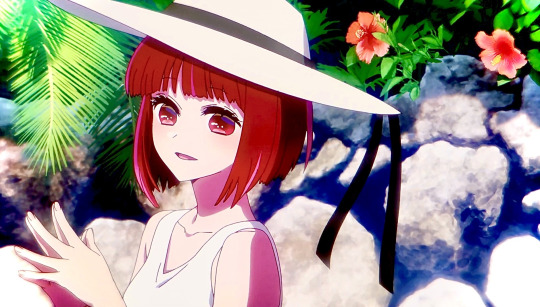
I was reading some AquKane shippers say something about how they don’t understand AquaKana, and why the writers and directors keep clearly pushing Kana towards Aqua when they barely share any chemistry. Whereas, in their belief, his relationship with Akane is more honest, deeper, whatever. I’m not here to argue about that. But I get where they’re coming from. And the simple explanation is this:
It’s because this whole story was written for Arima Kana.
I’ve seen some Youtubers talk about how this whole story was meant to be fulfillment for Ruby/Sarina’s dream to become the next great Idol, something about Amaterasu favoring her.
And that’s near what I thought of it. But I really think if the God of Entertainment wanted to bless a child with cancer a second life as the world’s great idol, they’d also give her a great singing voice, y’know?
Spoilers for the manga, of course as we go along on this explanation. So anime onlies, get caught up before you start reading me ramble.
Here we go:
1. Arima Kana is the embodiment of Amaterasu, not Ruby.
Or at least, Amaterasu’s appointed representative, or her favorite daughter.
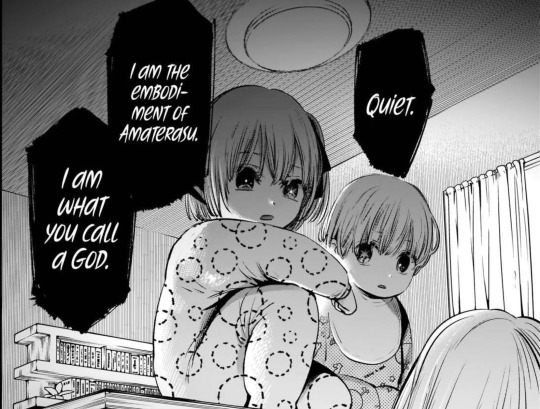
To give you a run-down of some of the core Shinto/Japanese Mythology that is important for the story, the Creator God Izanaki had three children:
Amaterasu, Goddess of the Sun.

Tsukuyomi, the Moon.
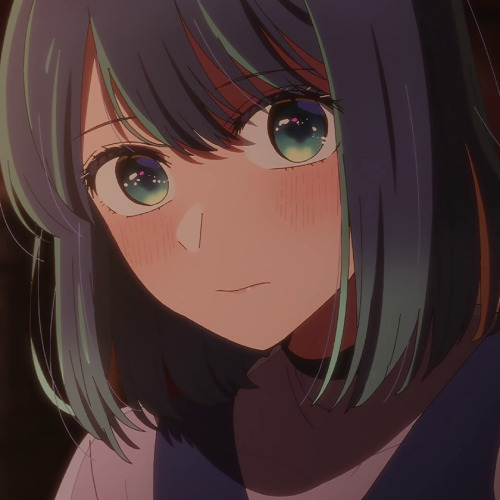
Susanoo, the Storm.
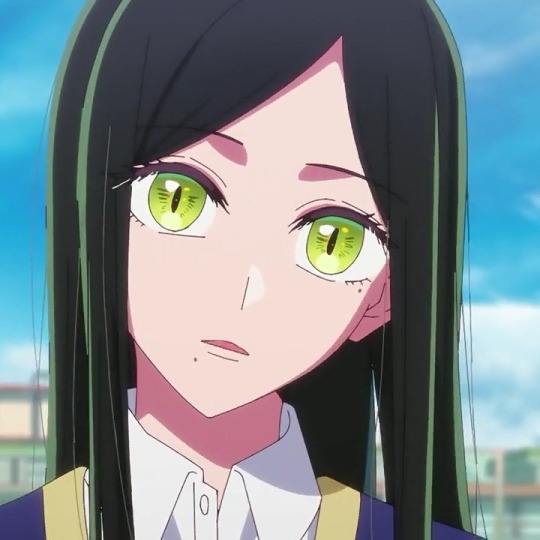
The story goes that Amaterasu and Susanoo had a competition about who could create better gods. So Amaterasu took Susanoo’s Totsuka-no-Tsurugi* (longsword) and split it into three, from which she birthed the three Munakata goddesses.
And woncha knowit, there are three great actresses born in that year?
*A reminder that Kana plays the character Tsurugi, which literally just means Sword. And Akane’s character Saya-hime just literally means Sheath or Scabbard Princess.
In this bet, Amaterasu got clever with the rules and won on a technicality. Susanoo went on a rampage, destroyed Amaterasu’s ricefield, and flayed Amaterasu’s favorite divine horse*, and then threw its body at her loom.
*The name Arima is spelled with the Kanji of Horse & Exist/Live.
Amaterasu, in her grief, flees into a cave, believed to be Amano Iwato cave, right in the town of Takachiho, Amamiya Gorou’s hometown, and the death place of Tendouji Sarina.
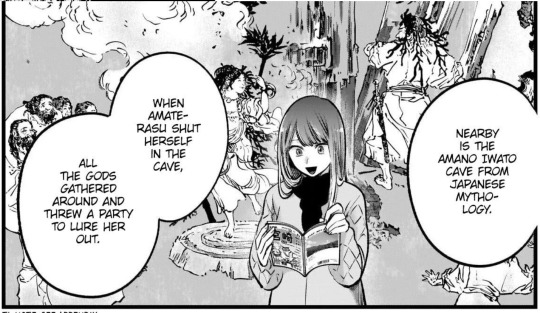
The being that draws Amaterasu out of there was the Goddess of the Dawn, known also as the Goddess of the Revelry & Arts, a being that Aqua says he knows well, and believes there’s a grain of truth to:
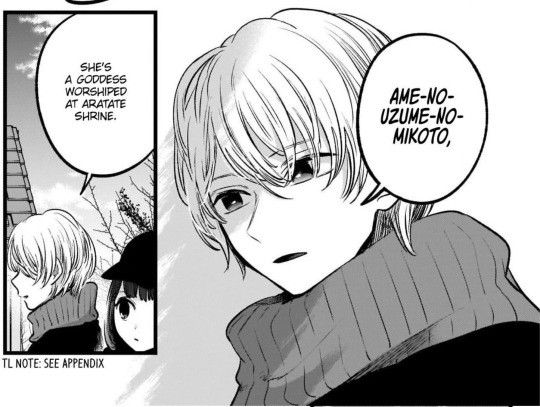
And how does Ame-no-Uzume draw Amaterasu out of her grief?
By throwing an absolute rager, and dancing really wildly that it catches her attention and makes all the gods around them laugh so hard. Just like:
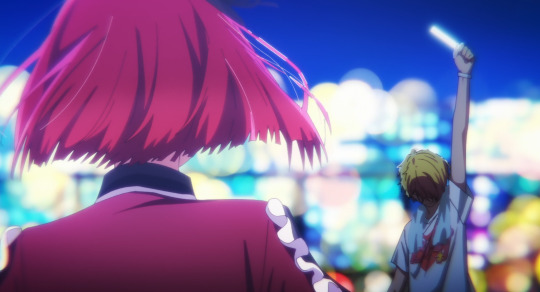
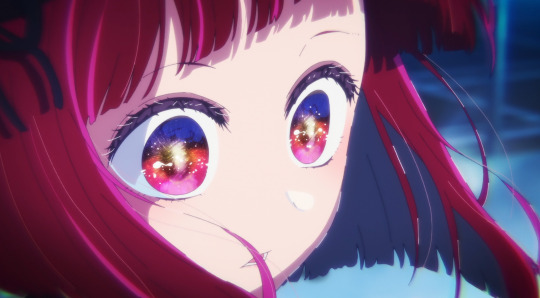

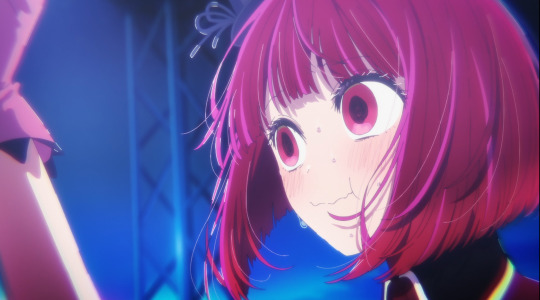
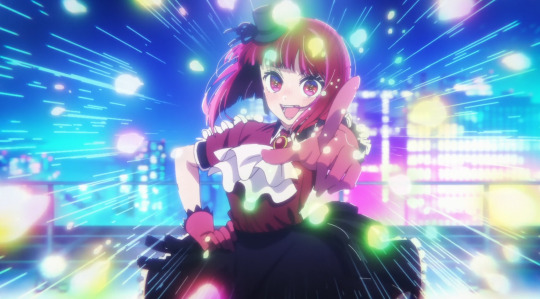
Ame-no-Uzume will later on marry a diety who tried to block her passage before, Sarutohiko, who in Ise is worshipped as the god who illuminates the world.
That’s some divinity-level AquaKana shipping right there.
Just like how Aka Akasaka wrote the story of Kaguya-sama: Love Is War about two lovers who couldn’t be together just like in the myth of Kaguya, but having his characters overcome all odds to defy divine fate, I do believe that apart from the parallels to the mythology like he did in Kaguya-sama, there is very literal divine intervention this time in Oshi No Ko.
I think what’s happening is that the gods, particularly Amaterasu and Susanoo are quarelling again about who could create better gods, just like before, but now more of whose favored child will shine the brightest and be worshipped by the most humans. But just like last time, Susanoo may have been enraged, especially at the sexual assault of his chosen Hikaru Kamiki, that he possessed him with a corrupting force that urges him to destroy shining stars before they reach their peak, hence the murders of Himekawa Airi, Hoshino Ai**, and Katayose Yura.
Which by the way, the name Hikaru means Radiant Light!
And Hoshino means Field of Stars!
Whether it’s because Amaterasu is angry that every daughter she sends to earth is slaughtered by Susanoo’s chosen, or just because she wants to win their competition, she appoints Ame-no-Uzume to assist in safeguarding her new favored one from Kamiki’s clutches. Her new favored one being Arima Kana.
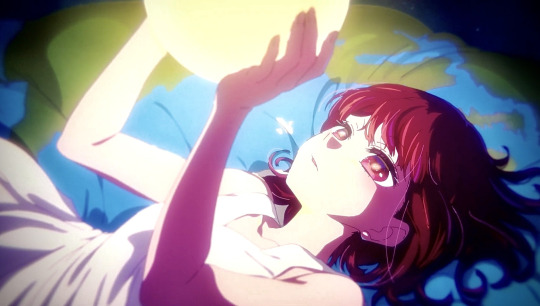
And therefore, Ame-no-Uzume takes the souls of two motherless humans who had passed before they could shine and sent them to become Hoshino Ai’s twin children. It was all anyway happening in her territory of Takachiho at the most opportune time.
Ame-no-Uzume is also known as The Goddess of Dance, as well as The Great Pursuader. And wouldn’t you know, that’s exactly the gifts that the Hoshino Twins received.
An energetic performer who takes the stage with dance:
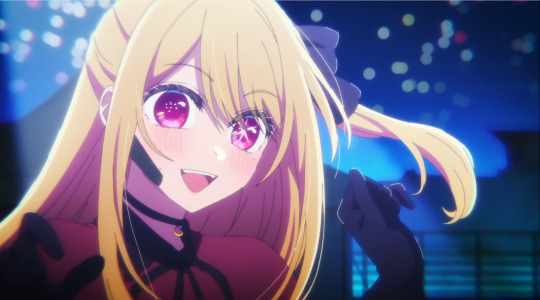
And a deceptive, persuasive, extremely believable actor, who:
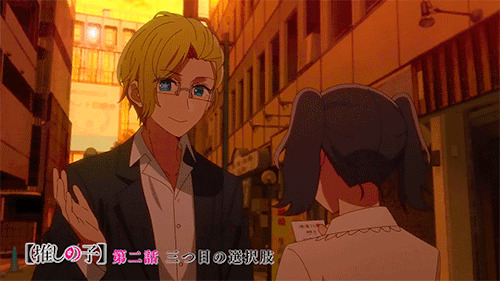
fooled his own sister into believing she had been rejected from an audition
pretended to scout an idol from a competing agency to research them
get Director Gotanda to raise him and train him
make Akane not just date him, but follow him down a destructive path
convince Kana and Mem to join IchigoPro
impersonate Pieyon for several days straight
Anyway, I truly, truly believe that unbeknownst to Aqua, his true mission is just to keep drawing Kana out of her darkness until she shines the brightest. Which is what he keeps doing anyway:

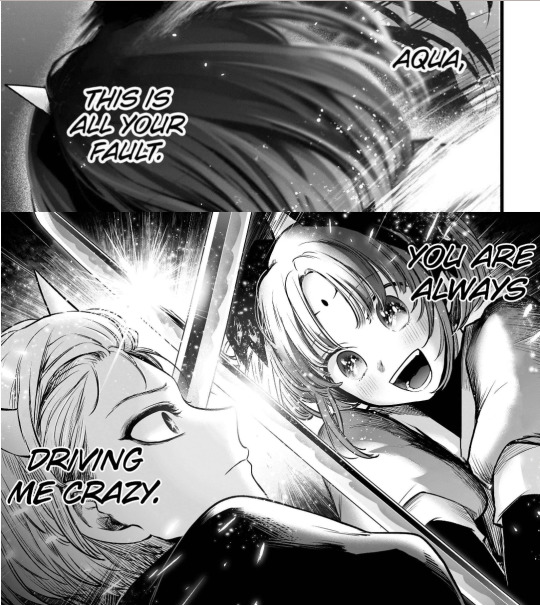
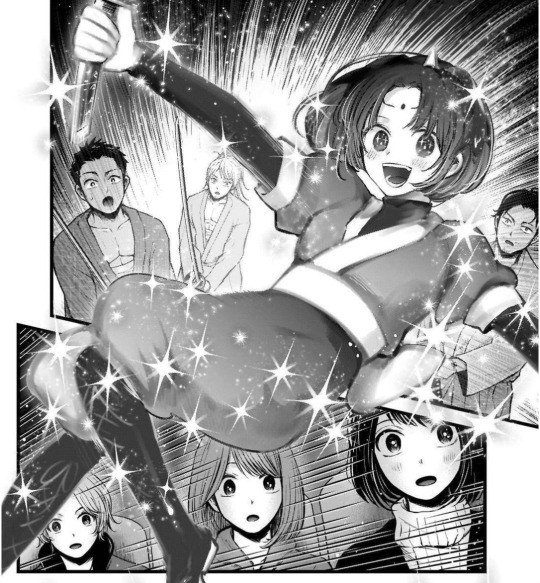

2. The Timing of the whole Oshi No Ko plot is aligned with Arima Kana’s rise to unprecedented stardom.
The story of Ai Hoshino’s pregnancy and meeting of Gorou Amamiya in a quaint hospital occurs at the beginning of Arima Kana’s life, just after she is born.
She meets Aqua Hoshino around age 4, already talented, and already extremely arrogant which could have easily been the demise of her career. But meeting Aqua and seeing his acting was a necessary wake-up call for her, that it brings her to tears. She never forgets this experience that she brought that lesson with her to her adulthood: that she can’t be satisfied and keep working harder, and to be a better communicator with her colleagues. At their first point of contact, Aqua already becomes the reason why Arima Kana’s acting career survives the slump.
They meet again in high school, when Arima Kana has one acting job in a lackluster production of Sweet Today. The ratings had plummeted, if not for the fact that Aqua came onto the set to draw out the best acting Arima Kana could deliver. After this, Arima receives much more respect and recognition from her colleagues in the industry beyond just being cast to bring some legitimacy to their production.
It’s because of Aqua and Ruby that Kana joins IchigoPro’s Idol Division, and her career is reborn anew. Such that, even after quitting B-Komachi, Arima states she never regretted the decision to join, because otherwise the career of Arima Kana would have been already over.
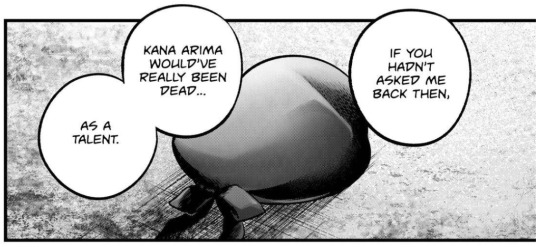
It’s because of Aqua’s presence that Arima trains to become better and better as an idol. Aqua kept drawing out the light from Kana’s eyes, to the point that it catches the attention of the crowd who previously had no interest in her.
It’s because of her experience as an idol that she regains the confidence and sense of greed necessary to grab the attention of the audience when on stage, such that even Akane recognizes this change in her when Arima takes the stage as Tsurugi for the 2.5 Adadptation of Tokyo Blade.
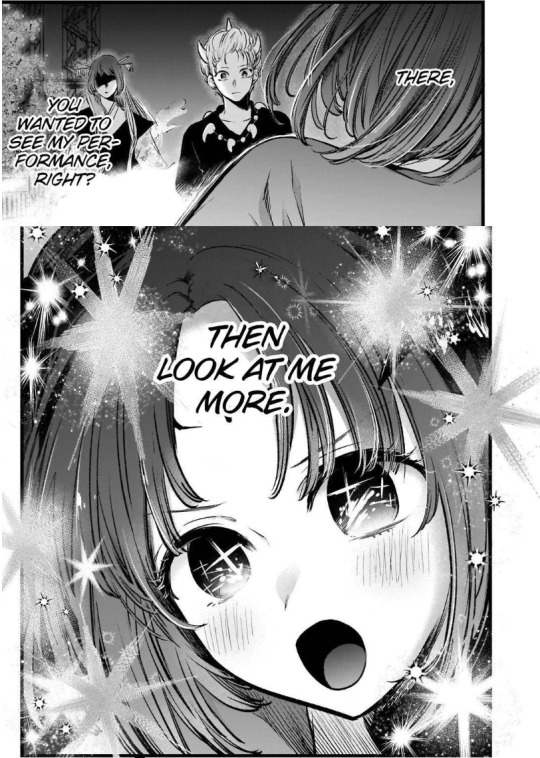

And it’s because of all of these that she captures the attention of award-winning Director Masanori Shima, who lines up some roles for her when her acting schedule had dried up. It’s once again because of Kana’s dedication towards Aqua that Shima D finds her so interesting that he was most willing to promise her the best role possible.

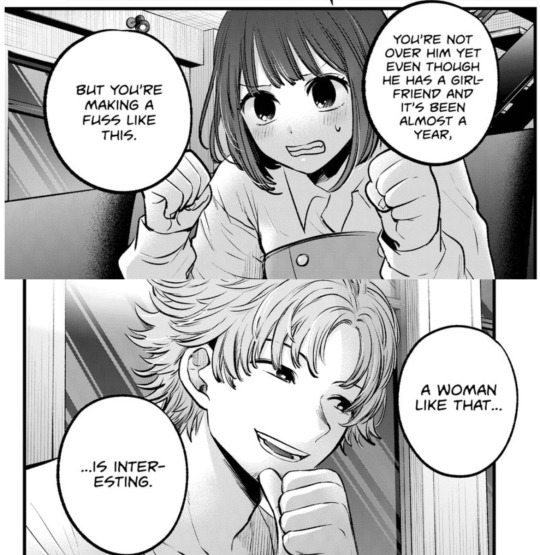
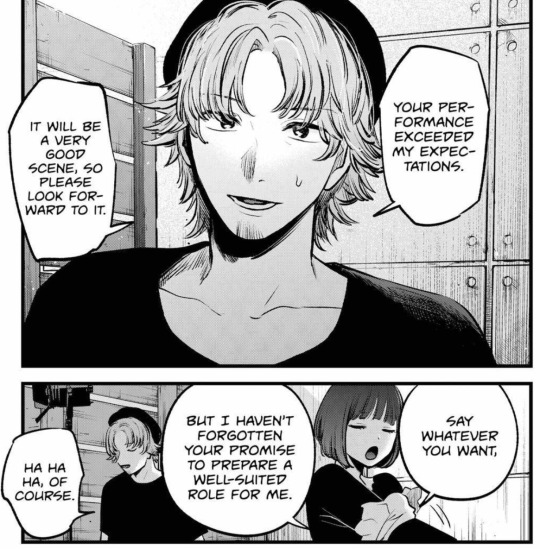
It was as if Ame-no-Uzume-no-Mikoto appointed Aqua and Ruby to come draw Arima Kana out of her Cave, and bring the Sun out again, just like how the deity drew out Amaterasu.
If you think about the title of the show, Oshi No Ko, it literally means The Favorite Child. God’s favored child. Arima Kana had been born chosen by Amaterasu from the very beginning. And Ame-no-Uzume is sending Aqua and Ruby to aid on this quest.
Which explains why it seems like there had been a mission communicated to Aqua from the very beginning. And why Ai was never going to be reincarnated at all.
You would think that if The Crow Girl, which we assume is the divine guide Yatagarasu, was communicating with Aqua about his revenge plan or helping him find Kamiki, that Aqua would hold a more favorable relationship with The Crow whenever it appears to give advice, no?
But it’s exactly the opposite. Because The Crow is guiding him into something that is different from his personal goal that Aqua doesn’t understand.
And this is where I think Arima Kana could be put in danger.
3. Arima Kana is Hikaru Kamiki’s next target.
There were earlier theories that thought Kurokawa Akane was the one to die next, because of what people have now learned of Kamiki’s serial murderer profile targeting big celebrities before their peak, and because Akane had received a bouquet of white roses from him when she won an award.
The chapter when it was expected to happen was a fake-out from Aka Akasaka, and some people think it’s still possible that she’s the target. In fact, I keep seeing recent theory videos who discount Kana and say she’s “the safest”. Hah! If only!
The scenes with Shima D weren’t just a mere plot point to bring scandal to Arima’s name, and threaten her career and life enough that it pushes Aqua to reveal his mother’s secret in exchange. But it’s there because this is the upward path for Arima Kana. So far, the only people who have witnessed her dazzling star power have been fans of the Sweet Today manga, idol otakus, and people who attended Tokyo Blade. That’s not really masterpiece-of-the-century, performing-at-the-dome level. None of these gigs have placed her center stage in what could be Film of the Year, and a Best Actress spot. Now, the chance is here, and it’s real:

I think, The 15-Year-Lie will attempt to draw out Hikaru Kamiki, or that Aqua intends to reveal himself in the movie looking like him, and reveal the identity of his father.
But I also think what would happen is that they would be unsuccessful at taking him down completely. Instead, from the movie, he would be interested in Arima Kana, and target her through the course of her Shima D movie, and plan to kill her before an important awards night.
Alternatively, now that Kana is changing her focus to film, she may consider moving agencies, and ask Frill Shiranui about her agent. And if we’re right, she is likely represented by Kamiki Productions.
Either way, Kamiki will pay attention to her and try to kill her just before she reaches her highest.
But I don’t think Arima Kana will die. I think instead of being saved by Aqua, it’ll be Kana who takes Kamiki down. Echoing back to her getting mad at Aqua for thinking that avoiding her was protecting her, and Aqua believing that Kana doesn’t need help since she’s strong enough to take care of herself.
And then maybe, it’s Arima Kana who draws Aqua out of the darkness too.
And, just like with Kaguya and Shirogane Miyuki, Aka Akasaka is once again writing a story about two people who will defy a fate of divine tragedy, and come out of it being more truthful with each other than they’ve been with themselves all along.
#oshi no ko#oshi no ko spoilers#arima kana#aqua hoshino#japanese mythology#shinto#shintoism#aqua x kana#hoshino aquamarine#onk spoilers#aquakana
693 notes
·
View notes
Text
Gauss Prime is a Fox.
How did I come to this conclusion? By first looking at Gauss Prime's signature armor set, Doppline Prime Armor.
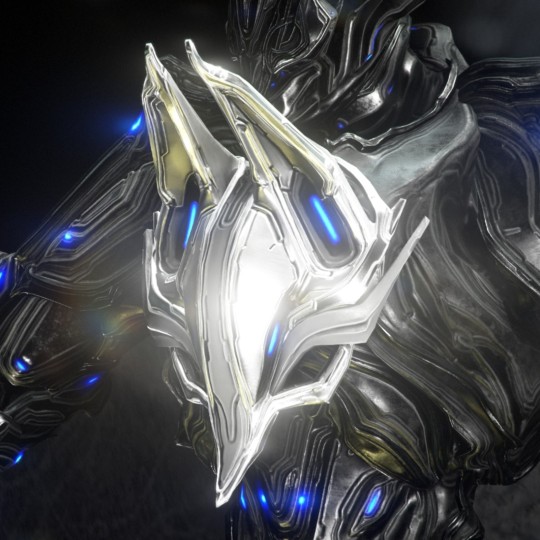
This is the chest armor of this set. It very clearly resembles the head of a fox. I was so curious as to why this could be. What association does Gauss' theme have with foxes? And what exactly does "Doppline" mean?
And then I remembered a line from the Gauss Prime Trailer.

Messengers of Gods. This seems fairly easy to interpret. One would quickly recall Hermes of Greek Mythology, famous for his incredible speed and being known as a "messenger" of the Olympians. But a "messenger of Gods" isn't an uncommon trope in various mythologies all around the world.
Connecting this fox motif to this line allowed me to recall a type of kitsune that served the kami (a spirit or god) Inari in Shintoism. Kitsune are (generally) known for their mischievous behavior (which we see in spades in the trailer) and their ability to shapeshift.
Then connecting this back to the Doppline Armor, I realized that Doppline is a portmanteau of "doppleganger" (a term often ascribed to a spirit that can assume the shape of a person, relating to kitsune shapeshifting) and vulpine ("having to do or related with foxes").
Gauss Prime is a celestial kitsune.
163 notes
·
View notes
Text
The Buddha in different religions/beliefs.

Firstly, who is the Buddha?:
The historical Buddha was a prince named Siddhartha Gautama who lived 2500 years ago in what is today northern India/Nepal. He was born into a warrior clan known as the Shakya, which is why he is often called Shakyamuni, “Sage of the Shakyas.” He is the one to later abandon worldly attachments, become enlightened, and found Buddhism.
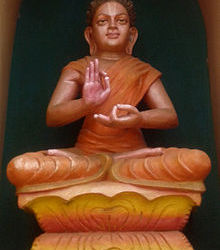
The Buddha in Hinduism.
Some Hindus consider the Buddha as the 9th avatar of Vishnu/Dashavatara, The Buddha was integrated into Vaishnavism, it was also believed the Buddha’s wife, Yasodhara, was the avatar of the wealth Goddess Lakshmi, though Buddhists deny this, so as other Hindus who identify the 9th avatar of Vishnu to another being who was also called “buddha”.

The Buddha in Christianity.
Called St. Josaphat (Budhasaf) of India, The story of St. Josaphat tells of a prince in India who is converted to Christianity by a monk, despite his father's attempts to prevent it. The monk and prince are later honored as saints in Christendom. The Buddha was honored as a Christian saint for about a thousand years, but this wasn't recognized until the mid 19th century.

The Buddha in Hellenism.
Buddhism had a big influence on ancient Greeks, in which they would identify Buddhist beings with Greek beings, the Greeks were also the first ones to make Buddhist statues. Heracules (or Zeus) was identified with The bodhisattva Vajrapani, whom was seen as Buddha’s protector. There also was a Syncretism between The Buddhist Goddess Hariti & Greek goddess tykhe.

The Buddha in Taoism.
Some Taoist believe that the Buddha was a reincarnation of Laozi, the founder of Taoism. Some also believe he was either on the same power-level as the Jade emperor, the Taoist king of heaven, or stronger than him. 'Buddha' is absorbed wholly into the Taoist cosmology, becoming another term used to describe the generative tissue at the source of all things in both the mental and physical realms.

The Buddha in Shinto.
Buddhism & Shinto are mostly seen highly entwined in Japan. The buddha is called Shaka in Japanese & was transformed into a powerful Japanese deity, whom coexisted with the Shinto gods. Buddhist temples were often attached to Shinto shrines. A Shinto temple would sometimes have a priest of that shrine read a Buddhist sutra in which Shinto events took place.
#buddhism#buddha#buddhist art#hinduism#christianity#hellenism#Taoism#daoism#shinto#shintoism#religions#the buddha#Siddhartha#gautama#siddhartha gautama#shakyamuni buddha#shakyamuni#desiblr#lotus-list#buddhistwitch#desi#desi tag#mahayana#vajrayana#theravada#zen
36 notes
·
View notes
Note
Reimu hakurei from touhou please









Reimu Hakurei (TouHou)
#livi’s moodboards#aesthetic#moodboards#moodboard#video games#red#white#Japan#ancient Japan#Miko#torii gate#Torii#shrine#Shinto#shintoism#shrine maiden#lanterns#yin Yang#reimu hakurei#TouHou#touhou project
26 notes
·
View notes
Text
Shinto: Japan’s Spiritual Tradition and Its Unique Elements

Shinto, one of Japan’s oldest religions, is a spiritual practice deeply rooted in the country’s culture and history. Unlike many Western religions, Shinto has no specific founder, single sacred book, or universalized doctrine. Instead, it is a spiritual tradition that focuses on the veneration of kami, spirits and deities that inhabit the natural world and its manifestations. This article explores the origins of Shinto, its core tenets, practices, and the religion’s continuing influence on contemporary Japanese society.
Origins and Development of Shinto Shinto has its roots in animistic practices and beliefs that predate the formation of Japan as a nation. Its history is closely intertwined with Japan’s cultural and political evolution, and many of its traditions have been shaped over the centuries by interactions with other religions, such as Buddhism and Confucianism.
The earliest written records of Shinto date back to the 8th century, with the compilation of texts such as the "Kojiki" (Records of Ancient Matters) and the "Nihon Shoki" (Chronicles of Japan). These texts describe Shinto mythology and the historical events associated with the formation of the first Japanese dynasties. Although Shinto has evolved over the centuries, its basic practices and beliefs have remained relatively consistent, centering on the worship of kami and maintaining harmony with nature.
Kami: Spirits and Deities in Shinto In Shinto, the concept of kami is central. Kami are spirits or deities that reside in natural elements such as mountains, rivers, trees, and other aspects of the natural environment. They can also be revered ancestors or supernatural beings with specific powers.
Nature Kami: Many kami are associated with specific natural phenomena and locations. For example, mountain kami are associated with strength and protection, while river kami may be associated with fertility and purity.
Ancestral Kami: In some traditions, kami are the spirits of important ancestors or revered historical figures. Ancestor worship is a way to honor their contributions and maintain a spiritual connection to the family line.
Imperial Kami: The Japanese imperial family is considered to be direct descendants of kami, especially the sun goddess Amaterasu. This gives the imperial family a sacred role, as they are seen as intermediaries between the gods and the Japanese people.
Shinto Shrines: Places of Worship and Rituals Shinto shrines, known as "jinja," are places of worship and worship where kami are revered. These shrines range in size and importance, from small communal altars to large complexes such as Ise Shrine, dedicated to Amaterasu.
Torii: One of the most recognizable symbols of Shintoism is the torii, a traditional gate that marks the entrance to a shrine. The torii symbolizes the transition from the profane to the sacred world and is often found at the entrance to Shinto shrines.
Honden and Haiden: Inside shrines, the main structure, called the honden, is where the kami are housed. The haiden is the place of worship where worshipers offer prayers and invocations.
Rituals and Festivals: Shinto rituals, known as matsuri, are events that celebrate the kami and the season. These festivals may include dances, music, and other activities that promote purification and gratitude.
Principles and Practices of Shintoism Shintoism does not have a uniform written doctrine, but its principles are centered on concepts of purity, harmony, and respect for nature:
Purity and Contamination: The notion of purity is essential in Shintoism. The concept of "kegare" refers to spiritual contamination, which can be caused by impure actions or negative events. Purification rituals, such as the use of water or the performance of specific ceremonies, are important to restore purity.
Harmony with Nature: Shintoism emphasizes the importance of living in harmony with nature and respecting the kami that inhabit the natural environment. The practice of reverence and gratitude for natural resources is a fundamental part of Shinto spirituality.
Rituals and Offerings: Shinto rituals often involve making offerings to the kami, such as food, drinks, and symbolic objects. These offerings are made to express respect, gratitude, and to ask for protection and blessings.
Influence of Shinto on Japanese Society
Shinto has had a profound influence on Japanese culture and society. Although Buddhism has become the predominant religion in Japan, Shinto continues to play an important role in daily life and cultural celebrations.
Weddings and Festivals: Many Japanese hold wedding ceremonies and New Year celebrations at Shinto shrines, reflecting the continued importance of religion in family life and cultural traditions.Rites of Passage: Shinto is also involved in rites of passage, such as naming ceremonies for newborns and festivals that mark important life moments.Cultural Preservation: Shinto contributes to the preservation of cultural traditions and artistic practices, such as annual festivals and the maintenance of traditional crafts and architecture.
Contemporary Challenges and Adaptations
Shinto, like many religious traditions, faces challenges in the modern era. Urbanization and globalization have impacted religious practice and the preservation of shrines and traditions. However, many Japanese continue to cherish and celebrate their Shinto traditions, adapting them to contemporary circumstances.
Conclusion
Shinto is a religion deeply rooted in Japanese history and culture, offering a spiritual vision that celebrates connection with nature and reverence for kami. Although it has evolved over the centuries and faced challenges in the modern world, Shinto continues to play a significant role in the lives of Japanese people, influencing their cultural and spiritual practices.
Through its traditions of purity, harmony, and respect for nature, Shinto offers a unique perspective on spirituality and the relationship between humans and the natural world. Its enduring presence and cultural practices reflect a rich heritage and enduring vision that continues to inspire and guide its followers.
Shinto, with its emphasis on reverence for spirits and nature, continues to be a fundamental part of cultural and spiritual life in Japan. As the country faces the changes of the modern world, Shinto offers a perspective of harmony and respect, while maintaining a deep connection to its ancient traditions and values.
30 notes
·
View notes
Text
Hot take regarding Heihachi Mishima coming back.
I know I said my page was going to be art focused from now on but I need to get this out of my chest.
I´m a veteran Tekken player, since 3 . I basically consumed any Tekken related media too (the mangas, comic books, the animated movie, the CGI movie, the horrible live action one, the anime on Netflix, etc)
Tekken 8 for me was a perfect conclusion for the story. I know that Kaz and Jun had an open ending but it was ok, she is going to take him to wherever she wants, maybe to retire, heal, you get it.
But... the whole clash between Kaz and Heihachi was CLOSED, ended in Tekken 7 in a very emotional manner, it was peak.
In Tekken 8, the final confrontation between Kaz and Jin was INCREDIBLE. I got shivers with Jun stands, T3 Jin theme ost, Angel Jin, etc...
It was cool as it is. It is true that Reina was very disappointing lore wise, I thought she was going to play a bigger role but it was, ok I guess??? leaving an opening to Tekken 9 as her as the main villain probably.
Now, after FINALLY progressing the story for all our main characters we get THE STUPID GRANDPA BACK. Seriously, am I the only one pissed??? it hasn´t even a WHOLE GAME without him. It makes zero sense, it destroys everything that happened during the climax of Tekken 7 and 8. We go back to the starting point. Is getting BORING and tiresome.
I get it... main Heihachi players missed him, cool. MAKE HIM A FLASHBACK.
Heihachi got his own flashback in Tekken 7 along with Kazumi and even though she was dead the whole time, she was still playable. They could have done the same with him.
Kazuya didn´t get ANY flashback of him and Jun in Tekken 2. Why???? Do we even know his aspirations appart from "muh control of the world" . NO. NOTHING.
They could have also bring Jinpachi back as a playable character in a flashback mode telling us about Kazuya childhood. But no... we got CANONICALLY GRANDPA RESURRECTED AGAIN.
Also... isn´t it misogynistic as well???? Jun was missing for +20 years in real time, she didn´t appear canonically since Tekken 2 and the old fart comes back not even one game later.
Same with Kazumi... she HAS THE DEVIL GENE. Heihachi only broke her neck ONCE and she can´t come back ???? COME ONE BAMCO.
Jin and Kazuya have died multiple times and survived others because the Devil Gene allows them to but not for Kazumi???? The true inheritor and probably pure blood devil gene user. WHAT THE ACTUAL FUCK.
Bruh... honestly. it pisses me off.
On the other hand... Heihachi gets thrown into a volcano, no human being can survive the erosion and melting of the body because of the lava.
Also, I´m pretty sure Heihachi didn´t gave her a proper shinto burial. She came out of a volcano in arcade mode, so Im 100% sure he just tossed her body along with the tiger into the lava. According to Shintoism, if someone doesn´t get a proper burial, they can come back as a vengeful ghost. So she can be brought back as well, not only as an evil ghost but also BECAUSE SHE HAD THE FUCKING DEVIL GENE.
I love Tekken lore to the core and Namco has just killed any progression the story had.
#tekken 8#tekken#rant post#personal rant#heihachi mishima#jun kazama#kazuya mishima#kazumi mishima#jin kazama#shintoism#reina mishima
36 notes
·
View notes
Text
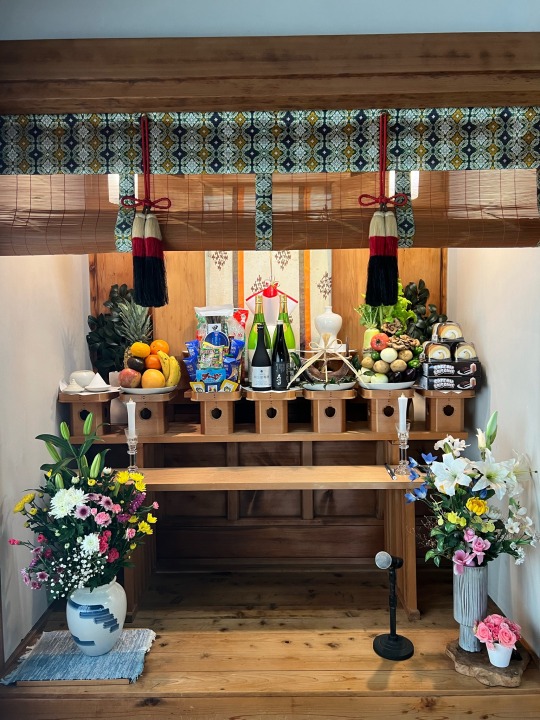
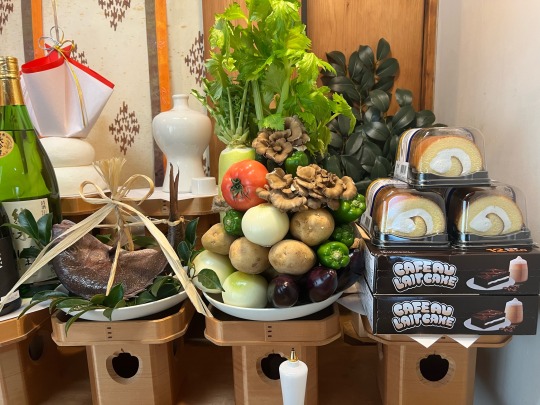
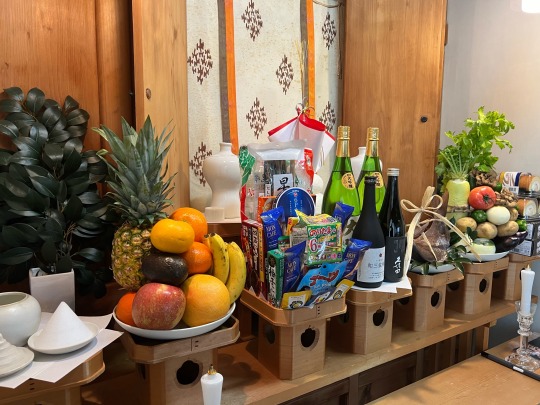

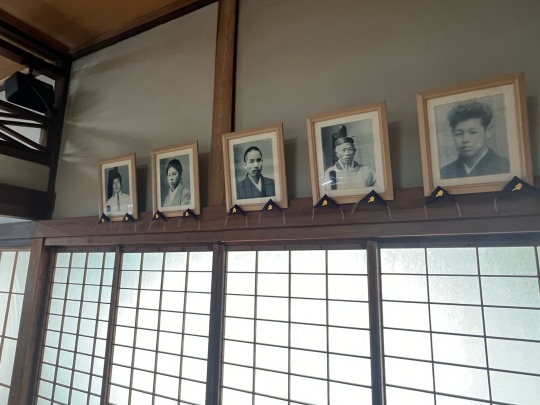


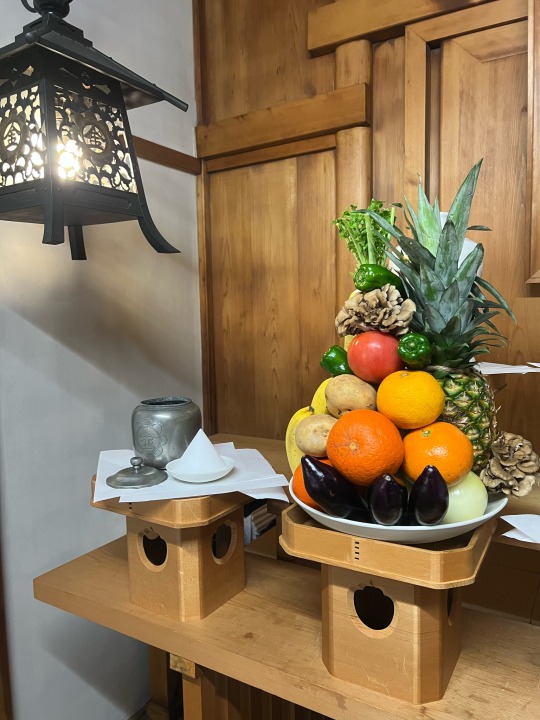


Happy Spring Equinox!
Today is the Spring Grand Ancestor Ceremony
春季霊大祭
We completed all the offerings, now time for the ceremony soon!🌸🌻
#shinto#shinto shrine#konkokyo#shintoism#konko faith#spring equinox#金光教横須賀教会#金光教#神道#春分の日#お供え物#offerings#altar
84 notes
·
View notes
Text

Kashima Shrine Pavillion, Watari, Miyagi (Northern Japan)
#Shintoism#Japan#Miyagi#original photographers#artists on tumblr#photography#photographers on tumblr#Japanese photographer#Natsoumi#写真家#山田なつみ#tohoku
13 notes
·
View notes
Text
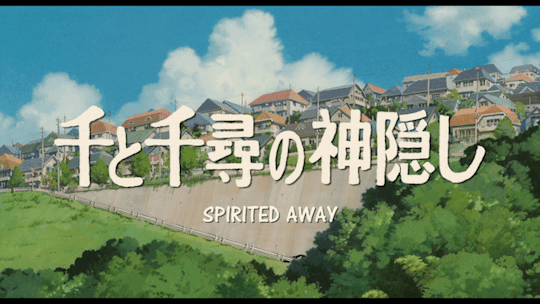





Spirited Away (2001)
Directed by Hayao Miyazaki
122 notes
·
View notes